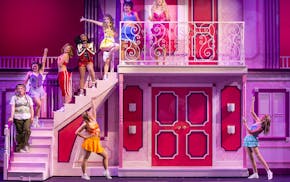For a place that has smells like a barn, the Minnesota State Fair has some good lessons on urban design. When you think about it, the fair is practically Utopia for some urban planners, with every attribute they think a livable city should have.
But does the fair have any lessons for real people who live in real cities? Let's see.
Walkability
Part of the joy of the fair comes from the casual amble across the fairgrounds with 100,000 of your fellow attendees. If you're able-bodied, you can get to any place on foot in a reasonable amount of time. The throngs may slow your pace on a busy day and you may find yourself waiting for a parade to pass before you can continue. But you come to walk. You cross the street without consulting a light. You never worry about someone blowing through a red light at 50 miles per hour.
Lesson: We hear a lot about walkability, but sometimes you need to drive to get to a walkable place (the Chain of Lakes, the Mall of America). There are 5,000 parking spaces in the lots around the fair, a vast expanse no one would want in a downtown. In a real city, you'd still need space for cars, whether that's ramps or unsightly lots on the perimeter of the central business district.
Commercial diversity
The shops and indoor bazaars like the grandstand and the Merchandise Mart are full of different wares, from food to Spin Art to food to auto dealers to food, food, cable TV, food, military recruitment, and food. Also, there's food.
No one goes to the fair for the purpose of getting a deal on satellite TV or buying a recliner or some salsa powder. Most of us don't go to the fair to shop. But we'd miss those booths and stands if they were gone. Just like we miss diverse retail in the downtowns of Minneapolis and St. Paul.
Lesson: We know downtown is too classy for ShamWow barkers and Ginsuknife hawkers, but why not put some in City Center or the Dayton's project? A crowd would surely form. No reason to wait until Christmas for a pop-up retail area downtown.
Monumentality
The fair is low-slung, so the big-ticket buildings stand out. The Emerald City pylon of the Agriculture/Horticulture Building, the blocky white 1930s WPA tower of the 4-H Building. Of course, the broad expanse of the grandstand, with its big white letters that proclaim the dates of the fair for all to see. (Not the most necessary piece of information, but it's tradition.) You can orient yourself wherever you are, by checking the skyline.
Lesson: Every town needs a landmark to help define itself. A church spire, a grain elevator, a water tower. As long as it's tall.
History
The fair has a way of seeming old and new at every turn. Even first-time visitors will know what's obviously old, even if you're not an expert on architectural styles. If you've been going to the fair year after year, you know what that used to be where. You can mourn the loss of things you remember from childhood, like the Chun King cafe (it had air conditioning!) or the old train cars in the West End, filled with junky bits of history, and you can still delight in what's new and better, such as the West End museum or the bathrooms by the DNR fire tower.
Lesson: All cities and towns are a mix of then and now. They wither when the people who shape them by edict stop coming up with interesting things for "now," and tear down most of "then."
A sin district
This would be the midway. Thrills, fear, gambling, teen mating rituals, beer-garden roisterers.
Lesson: An entertainment district doesn't have to be entirely upscale, with nice theaters and pricey shoes. We'll never get — nor would we want — a permanent carnival downtown, but imagine a great Ferris wheel on the banks of the Mississippi, perhaps part of a rehabbed Minneapolis Post Office complex with bars and a fair-style food court and maybe even some games of skill!
Visual interest
The eye is never bored at the fair. There's always something clamoring for your attention. A lot of it is garish, to be honest — a mix of plastic backlit signs and old homely handmade ones. But they're bright and cheerful.
Lesson: Many people would find fair-style signage in their neighborhood commercial nodes to be tacky, but a commercial district with lots of neon and bright signage tells you it's alive, and there are things to do.
Good mass transit
If you don't want to drive, take a shuttle. According to the fair's PR department, Metro Transit Express buses alone provided 241,000 rides to and from the fair in 2023. There's mass transit within the fair, as well, if you count the free trolleys, the Skyride gondola cars and the SkyGlider chairs that float north-south.
Lesson: Good mass transit means cheap, clean and safe. It's a bit unfair to compare the fair's mass transit experience to any real-world example, since the buses that serve the fairgrounds have a common destination and limited stops. And some, like the Park and Ride Express, are free. It's like a nice big limo full of happy, chatty people looking forward to a good time, or coming back from a good time, and that is not always the bus experience.
Perhaps we love the fair because it seems like the ideal small town. But it's actually a carefully controlled project that bears little resemblance to actual cities, because no one lives there. Can you imagine having an apartment above Andy's Grille, where they sing "Greased Lightning" every 20 minutes?
After all, the fair is a nice place to visit. But you wouldn't want to live there.

For 'Legally Blonde' star, 'being underestimated is her secret superpower'

Restaurant openings and closings in the Twin Cities

Minnesota's Amy Thielen launches old-fashioned radio show for food lovers
Yuen: How success has pushed Minnesotans off sidelines in trans athlete debate

